| Top Ten NYC Architecture | top 25 new york buildings | |||||||||||||||
| 1 | Empire State Building | |||||||||||||||
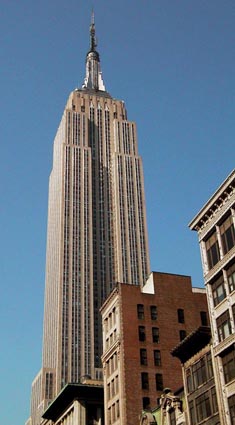 |
The Empire State Building has been named by the American Society of Civil Engineers as one of the Seven Wonders of the Modern World. The building and its street floor interior are designated landmarks of the New York City Landmarks Preservation Commission, and confirmed by the New York City Board of Estimate.[5] It was designated as a National Historic Landmark in 1986.[3][6][7] In 2007, it was ranked number one on the List of America's Favorite Architecture according to the AIA. The building is owned by Harold Helmsley's company and managed by its management/leasing division Helmsley-Spear. |
|||||||||||||||
| 2 |
Chrysler Building |
|||||||||||||||
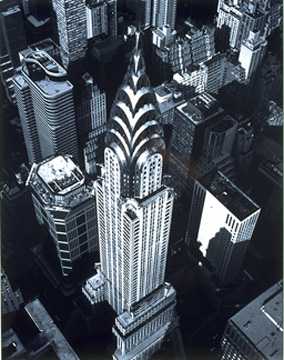 |
The Chrysler Building is an Art Deco skyscraper in New York City, located on the east side of Manhattan at the intersection of 42nd Street and Lexington Avenue. Standing at 319 m (1,047 ft) high,[1] it was briefly the world's tallest building before it was surpassed by the Empire State Building in 1931. However, the Chrysler Building remains the world's tallest brick building.[2][3] After the destruction of the World Trade Center, it was again the second tallest building in New York City until December 2007, when the spire was raised on the 365.8 m (1,200 ft) Bank of America building, pushing the Chrysler Building into third position. In addition, the New York Times Building, which opened in 2007, is exactly tied with the Chrysler Building in height, making the two buildings tied for 3rd position.[4] Despite the change in tallness ranking in New York, the Chrysler Building is still a classic example of Art Deco architecture and considered by many, at least among contemporary architects, to be one of the finest buildings in New York City. |
|||||||||||||||
| 3 | STATUE OF LIBERTY | |||||||||||||||
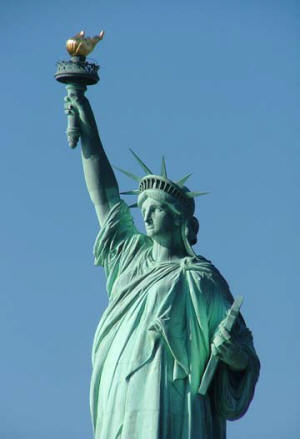 |
The statue is of a female figure walking upright, dressed in a robe and a seven point spiked rays representing a nimbus (halo), holding a stone tablet close to her body in her left hand and a flaming torch high in her right hand. The tablet bears the words "JULY IV MDCCLXXVI" (July 4, 1776), commemorating the date of the United States Declaration of Independence. The statue is made of a sheeting of pure copper, hung on a framework of steel (originally puddled iron) with the exception of the flame of the torch, which is coated in gold leaf. It stands atop a rectangular stonework pedestal with a foundation in the shape of an irregular eleven-pointed star. The statue is 151 feet 1 inch (46.5 m) tall, with the pedestal and foundation adding another 154 feet (46.9 m). Worldwide, the Statue of Liberty is one of the most recognizable icons of the United States,[2] and, more generally, represents liberty and escape from oppression. The Statue of Liberty was, from 1886 until the jet age, often one of the first glimpses of the United States for millions of immigrants after ocean voyages from Europe. Visually, the Statue of Liberty appears to draw inspiration from il Sancarlone or the Colossus of Rhodes. The statue is a central part of Statue of Liberty National Monument, administered by the National Park Service. |
|||||||||||||||
| 4 | St. Patrick's Cathedral | |||||||||||||||
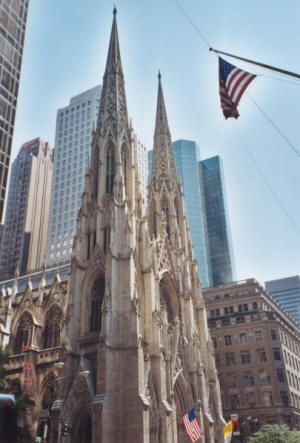 |
St. Patrick's Cathedral is the largest decorated Neo-Gothic-style Catholic cathedral in North America. It is the seat of the archbishop of the Roman Catholic Archdiocese of New York, and a parish church, located on Fifth Avenue between 50th and 51st streets in Manhattan. It faces Rockefeller Center. The Cathedral of New York's Catholic Archdiocese and seat of its Cardinal, in its early years this elaborate building served, among others, the working class, immigrant Catholic staff who were employed by the city's Episcopalian elite. The Cathedral's Gothic Revival design is based on French models. Somewhat generic in its form, it lacks the quaint flavor of Grace and Trinity Churches and the mysterious grandeur of St. John the Divine. A Lady Chapel, added to the Madison Avenue side of the Cathedral in 1906, is more impressive than the rest of the edifice. When construction began, the Cathedral was located on the outskirts of town in an area of slaughter houses and cattle yards. As construction progressed, the city advanced northwards to the area around St. Patrick's. Nevertheless, the site remained somewhat 'tainted' in the minds of 19th century New Yorkers. |
|||||||||||||||
| 5 | Grand Central Terminal | |||||||||||||||
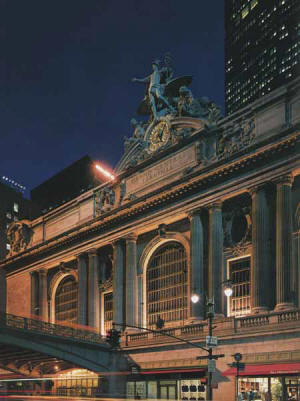 |
Grand Central Terminal (GCT, often inaccurately called Grand Central Station) is a Terminal station at 42nd Street and Park Avenue in Midtown Manhattan in New York City. Built by and named for the New York Central Railroad in the heyday of American long-distance passenger trains, it is the largest train station in the world by number of platforms:[3] 44, with 67 tracks along them. They are on two levels, both below ground, with 41 tracks on the upper level and 26 on the lower. It serves commuters traveling on the Metro-North Railroad to Westchester, Putnam, and Dutchess counties in New York State, and Fairfield and New Haven counties in Connecticut. Although it has been properly called "Grand Central Terminal" since 1913, many people continue to refer to it as "Grand Central Station". Technically, that is the name of the nearby post office, as well as the name of a previous rail station on the site. |
|||||||||||||||
| 6 | St.Regis-Sheraton Hotel | |||||||||||||||
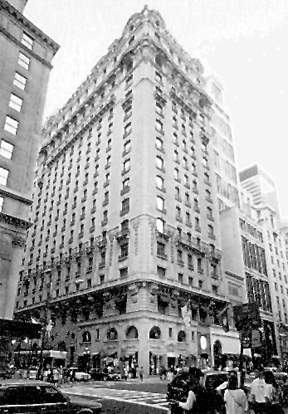 |
"The public rooms in the St. Regis were relatively small, a subtle indication that the management did not want the crowds that milled in Peacock Alley at the Waldorf-Astoria or in the vast lobby of the Astor in Times Square. On the Fifth Avenue side was an outdoor terrace were one could have refreshments, lost when Fifth Avenue was widened...During the nightclub years of the 1930's the St. Regis had many clubs, attracting for the most part a rather conservative and very well-heeled crowd. Joseph Urban[n], the flamboyant architect, designed the Seaglades nightclub, where Vincent Lopez's orchesta played. During the summer they played for dancing in the Japanese-style roof garden of the hotel," Patterson wrote, adding that the hotel was named after St. Regis Lake in the Adirondacks, a popular resort at the time. |
|||||||||||||||
| 7 | Metropolitan Museum of Art | |||||||||||||||
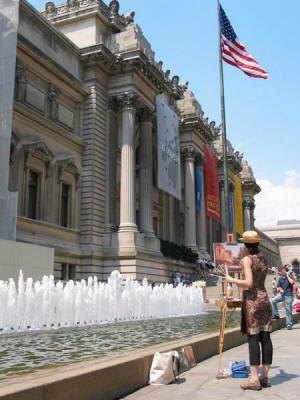 |
The Metropolitan Museum of Art, often referred to simply as "the Met", is one of the world's largest and most important art museums. The main building is located on the eastern edge of Central Park in New York City, New York, United States, along what is known as Museum Mile. It was designated a National Historic Landmark in 1986. The Met has a much smaller second location at "The Cloisters," featuring medieval art. |
|||||||||||||||
| 8 | Brooklyn Bridge | |||||||||||||||
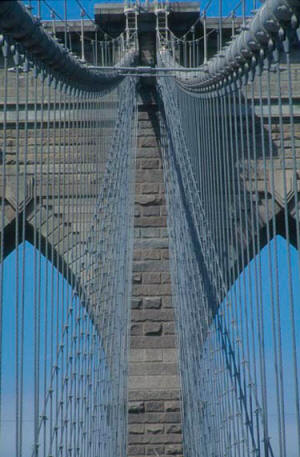 |
The Brooklyn Bridge, one of the oldest suspension bridges in the United States, stretches 5,989 feet (1825 m)[1] over the East River connecting the New York City boroughs of Manhattan and Brooklyn. On completion, it was the largest suspension bridge in the world and the first steel-wire suspension bridge. Originally referred to as the New York and Brooklyn Bridge, it was dubbed the Brooklyn Bridge in an 1867 letter to the editor of the Brooklyn Daily Eagle,[2] and formally so named by the city government in 1915. Since its opening, it has become an iconic part of the New York skyline. In 1964 it was designated a National Historic Landmark. |
|||||||||||||||
| 9 | St. John the Divine | |||||||||||||||
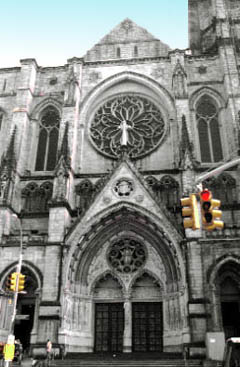 |
The Cathedral of St. John the Divine, officially the Cathedral Church of Saint John the Divine in the City and Diocese of New York, is the Cathedral of the Episcopal Diocese of New York. Located at 1047 Amsterdam Avenue New York, NY 10025 (between West 110th Street, which is also known as "Cathedral Parkway", and 113 Street) in Manhattan's Morningside Heights, the cathedral is claimed to be the largest cathedral and Anglican church and third largest Christian church in the world (although the title is disputed with Liverpool Anglican Cathedral). The cathedral, designed in 1888 and begun in 1892, has, in its history, undergone radical stylistic changes and the interruption of the two World Wars. It remains unfinished, with construction and restoration a continuing process. |
|||||||||||||||
| 10 | TRINITY CHURCH | |||||||||||||||
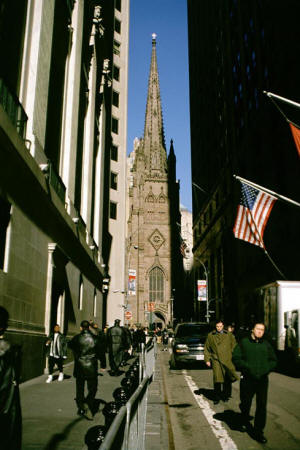 |
Trinity Church, at 74 Trinity Place in New York City, is a historic full service parish church in the Episcopal Diocese of New York. Trinity Church is located at the intersection of Broadway and Wall Street in downtown Manhattan. St. Paul's Chapel, part of the Parish of Trinity Church, is the oldest public building in continuous use in New York City. Trinity Episcopal Church in Fishkill, New York was started in 1756 with the missionary assistance of Trinity Church. Photo of Trinity Church and the schoolhouse of Trinity School (c. 17??). At the time of its completion, in 1846, its 281-foot spire and cross was the highest point in New York until being surpassed in 1890 by the New York World Building. On July 9, 1976, the church was visited by Queen Elizabeth II of the United Kingdom, and she was presented with a symbolic "back rent" of 279 peppercorns. Since 1993, Trinity church has been the location which the High School of Economics and Finance holds their senior graduation ceremonies. The school is located on Trinity Place (a few blocks away from the church). |
|||||||||||||||
| 11 | Woolworth Building | |||||||||||||||
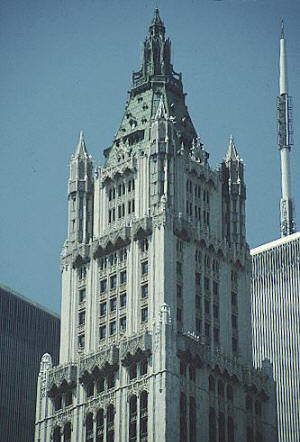 |
The Woolworth Building, at fifty-seven stories, is one of the oldest — and one of the most famous — skyscrapers in New York City. More than ninety years after its construction, it is still one of the fifty tallest buildings in the United States as well as one of the twenty tallest buildings in New York City. The building is a National Historic Landmark, having been listed in 1966. |
|||||||||||||||
| 12 |
Waldorf-Astoria Hotel |
|||||||||||||||
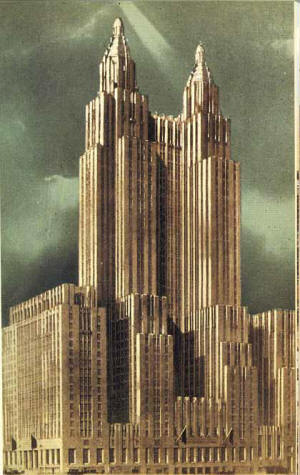 |
Waldorf=Astoria Hotel and Park Avenue with Helmsley Building and Met Life Building in backgroundThe Waldorf-Astoria Hotel is a famously luxurious hotel in New York. It has been housed in two historic landmark buildings of New York City. The first, designed by architect Henry J. Hardenbergh, was on the Fifth Avenue site of the Empire State Building. The present building at 301 Park Avenue in Manhattan is a 47-story, 625 ft. (191 m) Art Deco landmark designed by architects Schultze and Weaver that dates from 1931 and is now part of the The Waldorf=Astoria Collection, a chain of very upscale hotels consisting of hotels previously of the Hilton Hotels and Conrad Hotels chains, as well as some new hotels. The name, Waldorf=Astoria, now officially appears with a double hyphen, but originally the single hyphen was employed, as recalled by a popular expression and song, "Meet Me at the Hyphen." The modern hotel has three American and classic European restaurants, and a beauty parlor located off the main lobby. Several luxurious boutiques surround the distinctive lobby, which has won awards for its restoration to the original period character. An even more luxurious, virtual "hotel within a hotel" in its upper section is known as The Waldorf Towers operated by Conrad Hotels & Resorts. |
|||||||||||||||
| 13 | New York Public Library | |||||||||||||||
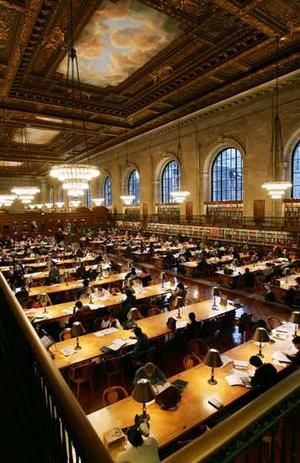 |
The New York Public Library (NYPL) is one of the leading public libraries of the world and is one of America's most significant research libraries. It is unusual in that it is composed of a very large circulating public library system combined with a very large non-lending research library system. It is simultaneously one of the largest public library systems in the United States and one of the largest research library systems in the world. It is a privately managed, nonprofit corporation with a public mission, operating with both private and public financing. Its flagship building, on Fifth Ave. running from 40th to 42nd Street in Manhattan, is a National Historic Landmark. The historian David McCullough has described the New York Public Library as one of the five most important libraries in America, the others being the Library of Congress, the Boston Public Library, and the university libraries of Harvard and Yale. Although it is called the "New York Public Library" the system does not cover all five boroughs of America's largest city, only Manhattan, The Bronx and Staten Island. New York City does not have a single public library system but three of them. The other two are the Brooklyn Public Library and the Queens Borough Public Library, serving the boroughs of Brooklyn and Queens, respectively. This came about because these three library systems predate the consolidation of New York City in 1898. |
|||||||||||||||
| 14 |
Hearst Magazine Building |
|||||||||||||||
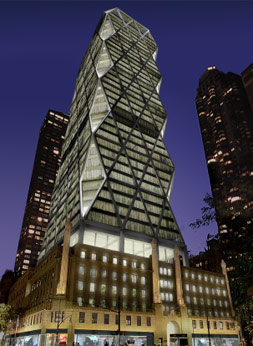 |
Hearst Tower in New York City, New York is located at 300 West 57th Street on Eighth Avenue, near Columbus Circle. It is the world headquarters of the Hearst Corporation, bringing together for the first time their numerous publications and communications companies under one roof, including Cosmopolitan, Good Housekeeping and the San Francisco Chronicle, to name a few. The former six-story headquarters building was commissioned by the founder, William Randolph Hearst and awarded to the architect Joseph Urban. The building was completed in 1928 at a cost of $2 million and contained 40,000 sq. ft. The original cast stone facade has been preserved in the new design as a designated Landmark site. Originally built as the base for a proposed skyscraper, the construction of the tower was postponed due to the Great Depression. The new tower addition was completed nearly eighty years later, and 2000 Hearst employees moved in on 4 May 2006.[1] |
|||||||||||||||
| 15 | Flatiron Building | |||||||||||||||
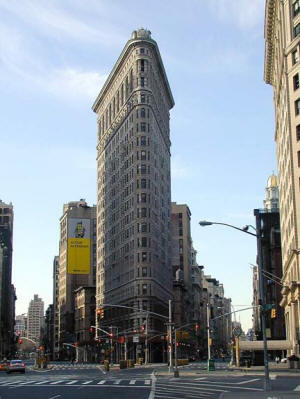 |
The Fuller Building, better known as the Flatiron Building, was one of the tallest buildings in New York City upon its completion in 1902. The building, at 175 Fifth Avenue in the borough of Manhattan, sits on a triangular island block at 23rd Street, Fifth Avenue, and Broadway, facing Madison Square. The Flatiron Building was designed by Chicago's Daniel Burnham in the Beaux-Arts style. Like a classical Greek column, its limestone and glazed terra-cotta façade is separated into three parts horizontally. Since it was one of the first buildings to use a steel skeleton, the building could be constructed to 285 feet (87 m), which would have been very difficult with other construction methods of that time. The initial design by Daniel Burnham shows a similar design to the one constructed, but with a far more elaborate crown with numerous setbacks near the pinnacle. A clock face can also be seen. However, this was later removed from the design. |
|||||||||||||||
| 16 | Solomon R. Guggenheim Museum | |||||||||||||||
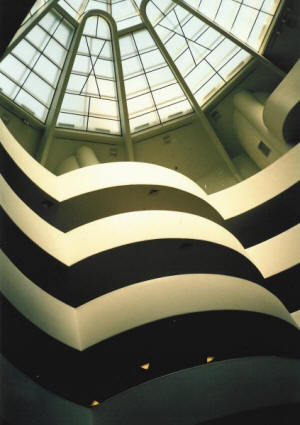 |
Originally called "The Museum of Non-Objective Painting," the Guggenheim was founded to showcase avant-garde art by early modernists such as Wassily Kandinsky and Piet Mondrian. It moved to its present location, at the corners of 89th Street and Fifth Avenue (overlooking Central Park), in 1959, when Frank Lloyd Wright's design for the site was completed. The distinctive building, Wright's last major work, instantly polarized architecture critics, though today it is widely revered. From the street, the building looks approximately like a white ribbon curled into a cylindrical stack, slightly wider at the top than the bottom. Its appearance is in sharp contrast to the more typically boxy Manhattan buildings that surround it, a fact relished by Wright who claimed that his museum would make the nearby Metropolitan Museum of Art "look like a Protestant barn." Internally, the viewing gallery forms a gentle spiral from the ground level up to the top of the building. Paintings are displayed along the walls of the spiral and also in viewing rooms found at stages along the way. |
|||||||||||||||
| 17 |
The Plaza Hotel |
|||||||||||||||
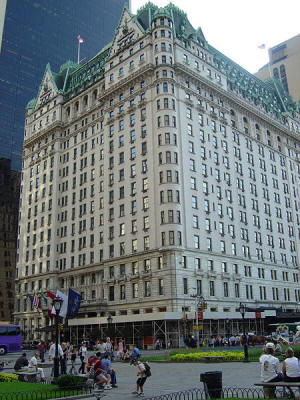 |
"The Plaza has been able to maintain its standings over the years. The Plaza's various public rooms have undergone numerous incarnations. The large room on the corner of Forty-ninth Street and the Plaza, which was called simply the "restaurant," assumed various decors as the Edwardian Room and the Green Tulop, and the Fifty-ninth Street dining room that served as the office of Jules Bache has become, and Remains, the Oak Room." "Finally, the Plaza houses New York's one functioning Palm Court, and it has a busy day. Breakfasts and salad lunches are served, and no sooner are the last leaves of lettuce carried away than a violinist and pianist turn up and a flame is put under the tea kittles and cocoa in the kitchens. This does not mean, however, that the Plaza has not plugged ahead into the future. Not only does it provide its guests with closed circuit television and choice of two movies daily, but troubleshooting hostesses called "service coordinators," together speaking all of fifteen languages, patrol the lobby and halls where once private maids and lackies scurried obediently." The Plaza Hotel, one of New York city's finest hotels, was architecturally designed imitating the style of a late medieval French chateaux. The elegant lobby contains ornamented archways, pillars, and marble floors. This combined with a usage of the color gold give the hotel a wealthy, upper-class appearance. |
|||||||||||||||
| 18 | Lincoln Center | |||||||||||||||
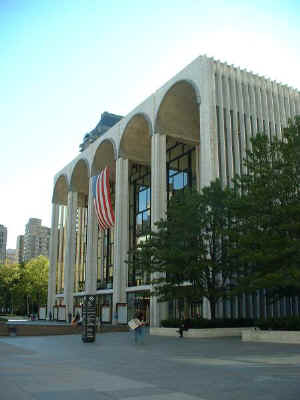 |
Lincoln Center for the Performing Arts is a 16.3-acre (61,000 m²) complex of buildings in New York City which serves as home for 12 arts organizations: Chamber Music Society of Lincoln Center, Film Society of Lincoln Center, Jazz at Lincoln Center, Juilliard School, Lincoln Center Theater, Metropolitan Opera, New York City Ballet, New York City Opera, New York Philharmonic, New York Public Library for the Performing Arts, School of American Ballet, and Lincoln Center for the Performing Arts, Inc.. |
|||||||||||||||
| 19 | Dakota Apartments | |||||||||||||||
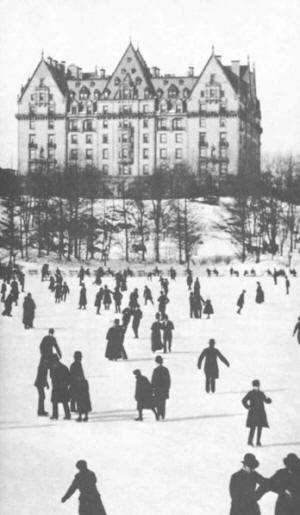 |
The architectural firm of Henry Janeway Hardenbergh was commissioned to do the design for Edward Clark, head of the Singer Sewing Machine Company whose firm also designed the Plaza Hotel. The building's high gables and deep roofs with a profusion of dormers, terracotta spandrels and panels, niches, balconies and balustrades give it a North German Renaissance character, an echo of a Hanseatic townhall. Nevertheless, its layout and floor plan betray a strong influence of French architectural trends in housing design that had become known in New York in the 1870s. According to popular legend, the Dakota was so named because at the time it was built, the Upper West Side of Manhattan was sparsely inhabited and considered as remote as the Dakota Territory. However, the earliest recorded appearance of this account is in a 1933 newspaper story. It is more likely that the building was named "The Dakota" because of Clark's fondness for the names of the new western states and territories. High above the 72nd Street entrance, the figure of a Dakota Indian keeps watch. The Dakota was added to the National Register of Historic Places in 1972, and was declared a National Historic Landmark in 1976. |
|||||||||||||||
| 20 | Radio City Music Hall | |||||||||||||||
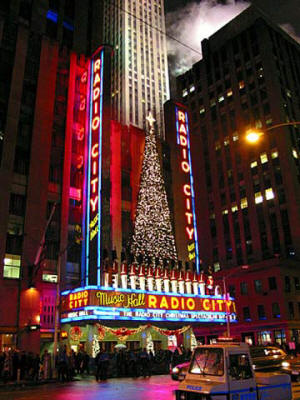 |
The 12 acre (49,000 m²) complex in midtown Manhattan known as Rockefeller Center was developed between 1929 and 1940 by John D. Rockefeller, Jr., on land leased from Columbia University. Rockefeller initially planned a new home for the Metropolitan Opera on the site, but after the Stock Market Crash of 1929, the plans changed and the opera company withdrew from the project. The names "Radio City" and "Radio City Music Hall" derive from one of the complex's first tenants, the Radio Corporation of America. Radio City Music Hall was a project of Rockefeller, Samuel Roxy Rothafel who previously opened the Roxy Theater in 1927, and RCA chairman David Sarnoff. RCA had developed numerous studios for NBC at 30 Rockefeller Plaza, just to the south of the Music Hall, and the radio-TV complex that lent the Music Hall its name is still known as the NBC Radio City Studios. The Music Hall opened to the public on December 27, 1932 with a spectacular stage show, featuring Ray Bolger and Martha Graham. The opening was meant to be a return to high class variety entertainment. Unfortunately, it was not a success and on January 11, 1933, the first film was shown on the giant screen: Frank Capra's The Bitter Tea of General Yen starring Barbara Stanwyck. |
|||||||||||||||
| 21 | Time Warner Center | |||||||||||||||
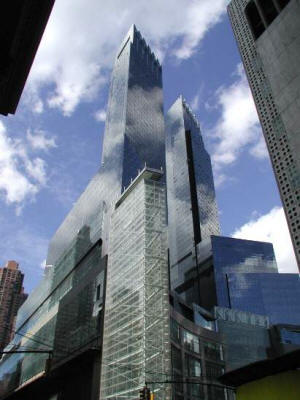 |
Originally constructed as the "AOL Time Warner Center," the building surrounds half of Columbus Circle in Midtown Manhattan. The total floor area of 260,000 m² (2.8 million ft²) is divided between offices (notably the offices of Time Warner Inc.), residential condominiums, and the Mandarin Oriental hotel. The Shops at Columbus Circle is an upscale shopping mall located in a curving arcade at the base of the building, with a large Whole Foods Market grocery store in the basement. The complex is also home to a 1,200 seat theater for Jazz at Lincoln Center as well as CNN studios, from where Anderson Cooper 360° and Lou Dobbs Tonight, among other shows, are broadcast live. CNN's Jeanne Moos, known for her offbeat "man on the street" reporting, frequently accosts her interview subjects just outside the building. In 2005, Jazz at Lincoln Center announced a partnership with XM Satellite Radio which gave XM studio space at Frederick P. Rose Hall to broadcast both daily jazz programming and special events such as an Aartist Confidential show featuring Carlos Santana. |
|||||||||||||||
| 22 |
United Nations Headquarters |
|||||||||||||||
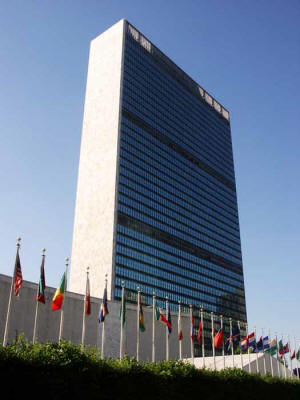 |
The United Nations Headquarters were constructed in New York City in 1949 and 1950 beside the East River, on seventeen acres of land purchased from the foremost New York real estate developer of the time, William Zeckendorf. This purchase was arranged by Nelson Rockefeller, after an initial offer of placing it on the Rockefeller family estate of Kykuit was rejected as being too isolated from Manhattan. The $8.5 million purchase was then funded by his father, John D. Rockefeller, Jr., who donated it to the City. The lead architect for the building was the real estate firm of Wallace Harrison, the personal architectural adviser for the family. |
|||||||||||||||
| 23 | TWA Terminal JFK Airport | |||||||||||||||
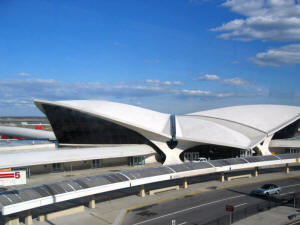 |
|
|||||||||||||||
| 24 | Citicorp Center | |||||||||||||||
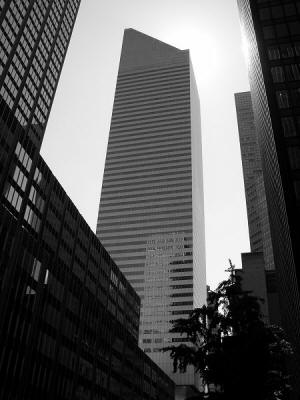 |
From the beginning, the Citigroup Center was an engineering challenge. When planning for the skyscraper began in the early 1970s, the northwest corner of the proposed building site was occupied by St. Peter's Lutheran Church. The church allowed Citicorp to demolish the old church and build the skyscraper under one condition: a new church would have to be built on the same corner, with no connection to the Citicorp building and no columns passing through it, because the church wanted to remain on the site of the new development, near one of the intersections. Architects wondered at the time if this demand was too much, and if the proposal could even work. Structural engineer William LeMessurier set the 59-story tower on four massive 114 foot (35 m) high columns, positioned at the center of each side, rather than at the corners. This design allowed the northwest corner of the building to cantilever 72 feet (22 m) over the new church. To accomplish these goals LeMessurier designed a system of stacked load bearing braces, in the form of inverted chevrons. Each chevron would redirect the massive loads to their center, then downward into the ground through the uniquely-positioned columns. |
|||||||||||||||
| 25 |
Museum of Modern Art |
|||||||||||||||
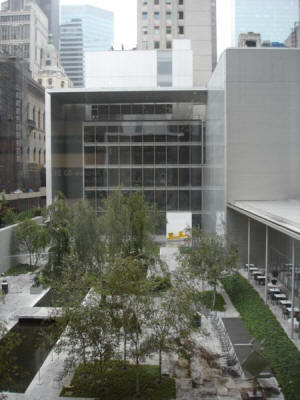 |
The Museum of Modern Art (MoMA) is a preeminent art museum located in Midtown Manhattan in New York City, USA, on 53rd Street, between Fifth and Sixth Avenues. It has been singularly important in developing and collecting modernist art, and is often identified as the most influential museum of modern art in the world.[1] The museum's collection offers an unparalleled overview of modern and contemporary art, [2] including works of architecture and design, drawings, painting, sculpture, photography, prints, illustrated books, film, and electronic media. MoMA's library and archives hold over 300,000 books, artist books, and periodicals, as well as individual files on more than 70,000 artists. The archives contain primary source material related to the history of modern and contemporary art. |
|||||||||||||||